- blog
- Sales Development
- How to Reach B2B Decision Makers: Complete 2025 Guide
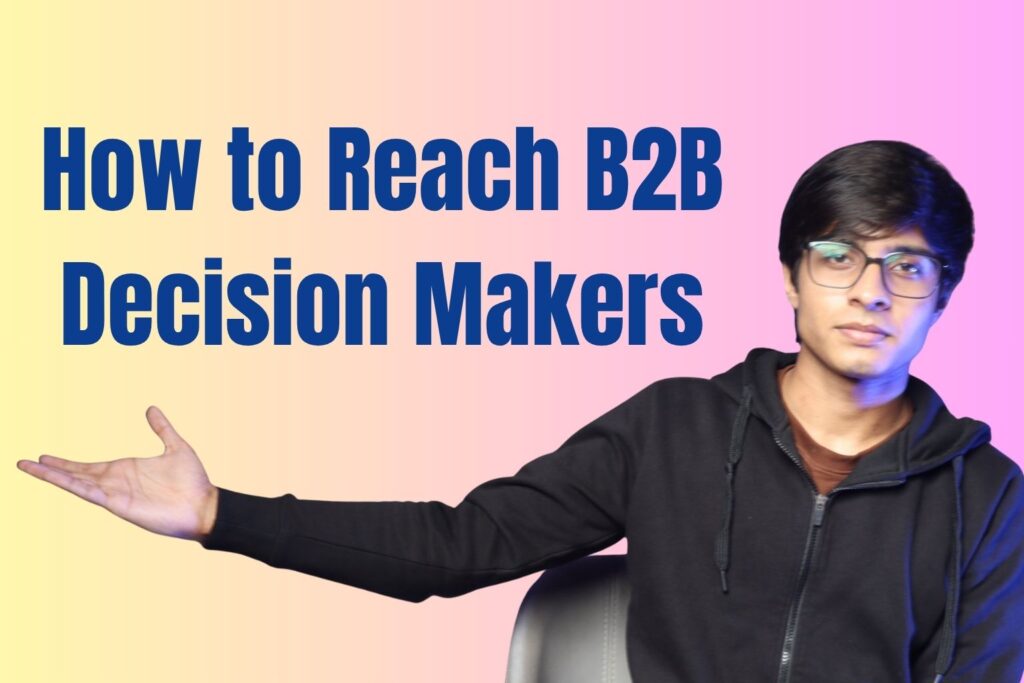
How to Reach B2B Decision Makers: Your 2025 Playbook for Closing More Deals
Table of Contents
The B2B sales landscape has transformed completely. Gone are the days when you could reach one executive, get a handshake, and close a deal. Today’s reality? A shocking 6 to 10 decision makers are involved in every significant B2B purchase, and 81% of buyers express dissatisfaction with their chosen provider even after this lengthy process.
If you’re struggling to connect with the right people or watching deals stall in endless committee discussions, you’re not alone. Up to 86% of B2B purchases stall before a decision is ever made. But here’s the good news: understanding how to reach decision makers in business isn’t rocket science – it’s a systematic process that anyone can master.
This guide breaks down exactly how to reach B2B decision makers, identify the real influencers, and craft outreach that actually gets responses. No fluff, just proven strategies that work.
Who are Business Decision Makers?
Stop hunting for a single “decision maker” – that person barely exists anymore. Instead, you’re dealing with a Decision-Making Unit (DMU) or buying committee. This group approach is driven by one powerful emotion: fear. With so much at stake, companies form committees to spread risk, which is why 40% to 60% of all B2B deals end in “no decision”.
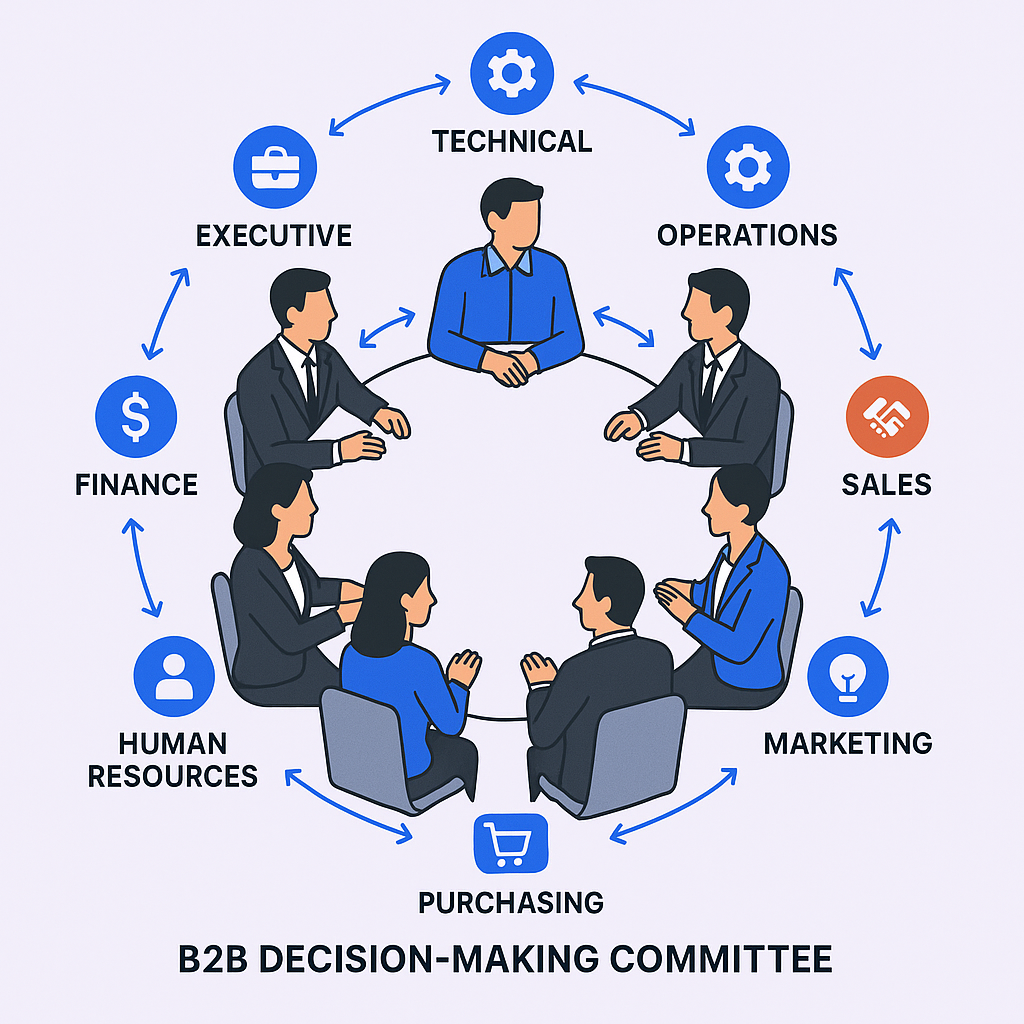
The modern b2b decision making process involves diverse stakeholders from multiple departments. Research shows 89% of purchases involve two or more departments, which explains why the average B2B buying cycle has stretched to 11.5 months.
Your job isn’t just to sell a product – it’s to build consensus across an entire group and make everyone feel confident in choosing you.
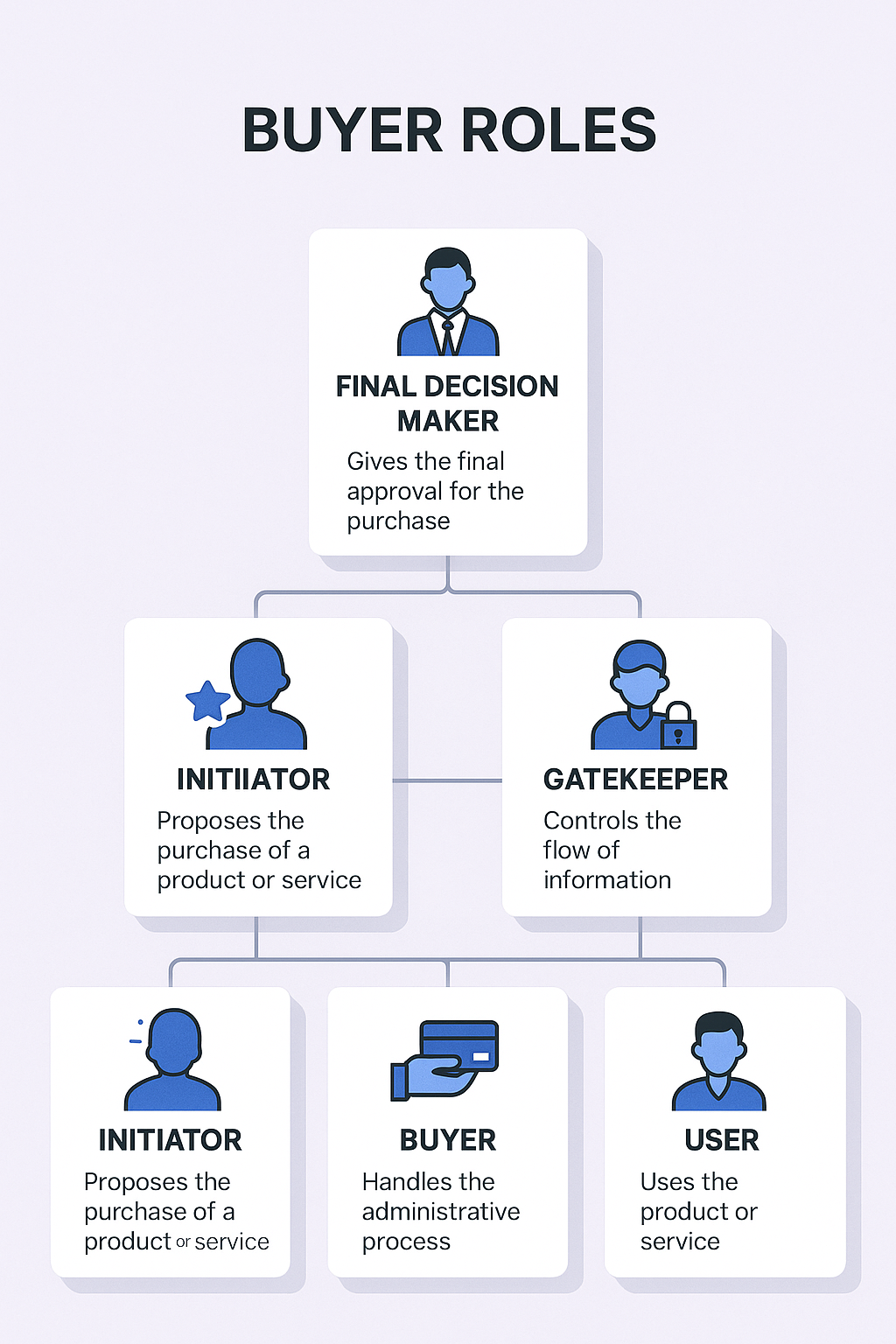
Key Roles of Business Decision Makers
Understanding the buying committee is like knowing the cast of a play. Each person has a specific role, and you need to tailor your approach to every one of them:
The Initiator identifies the problem and kicks off the buying journey. They might be a marketing manager drowning in manual tasks who needs a new CRM. Your goal: Help them build a compelling business case.
The Influencer is the technical expert whose opinion carries massive weight. This could be an IT Director evaluating security or a senior engineer vetting capabilities. Your goal: Win them over with data and proof your solution works.
The Gatekeeper controls information flow and access to key players – often an executive assistant or junior manager. They’re not obstacles; they’re crucial allies. Your goal: Build genuine rapport and earn their trust.
The Buyer handles budgets and negotiations, usually from procurement or finance. They focus on ROI and total cost of ownership. Your goal: Justify your price with clear financial benefits.
The User will interact with your product daily. Their buy-in is non-negotiable – if they find it difficult to use, they can kill the deal. Your goal: Show how your solution makes their job easier.
The Final Decision Maker has ultimate approval authority, often a C-level executive. Research shows 79% of B2B purchases require CFO approval. Your goal: Align with their strategic goals.
Types of Decision Makers
Beyond roles, you need to understand personalities. People make decisions differently, and tailoring your communication style to their psychological profile is the secret to building rapport.
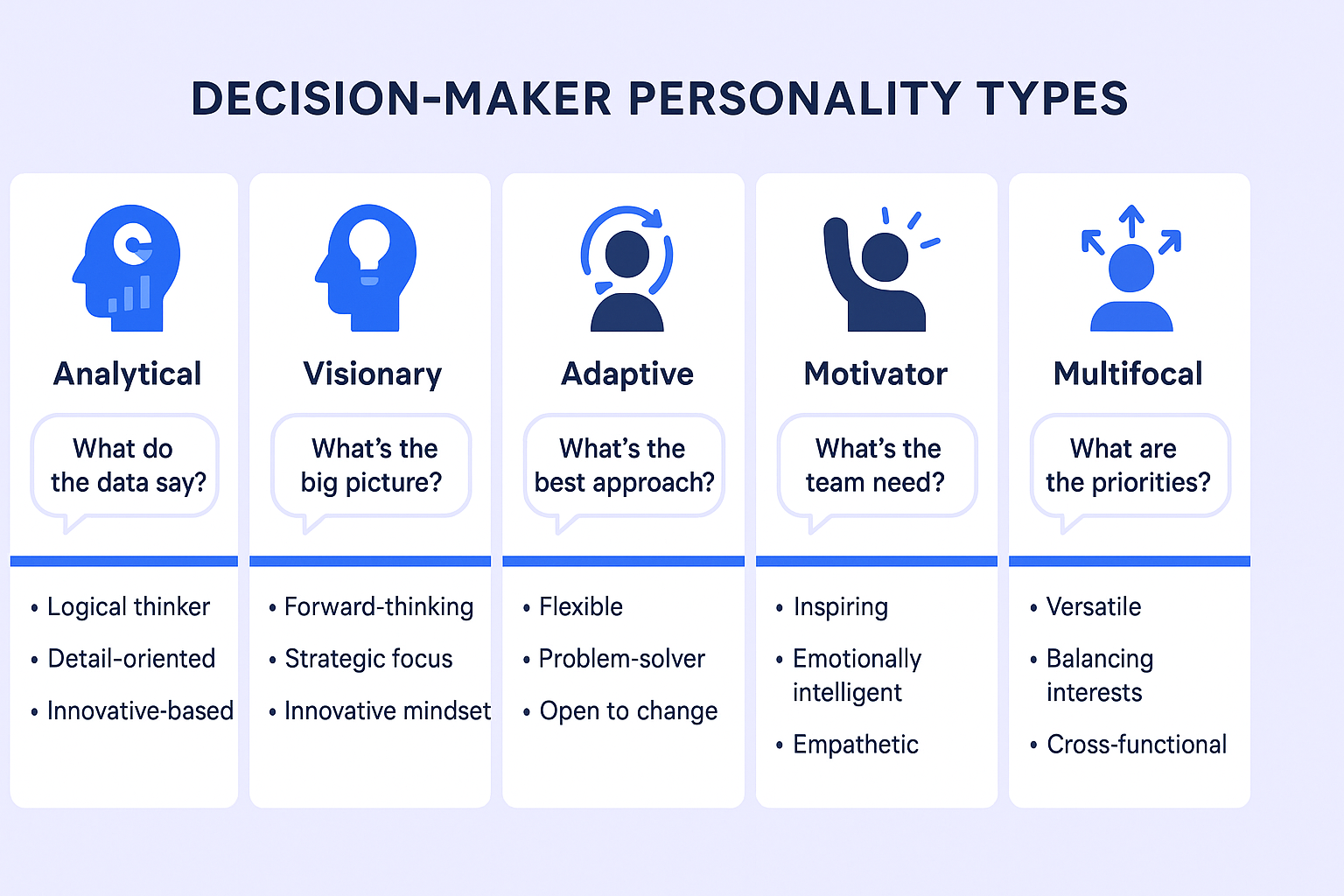
Analytical
Their core question: “What’s the ROI? ShThese decision makers live and breathe data. They want hard numbers, detailed specifications, and measurable results. Use language like “efficient,” “proven,” “optimized,” and “data-driven.”ow me the proof.”
Provide them with financial models, case studies with specific metrics, and detailed technical specifications. Avoid vague claims, emotional appeals, or high-pressure tactics.
Visionary
Their core question: “How does this give us a strategic advantage?”
Visionaries think big picture and focus on competitive positioning. They want to understand how your solution transforms their business or industry. Use words like “transform,” “innovate,” “growth,” and “market leader.”
Share future-state scenarios, social proof from industry leaders, and competitive analysis. Don’t get bogged down in minor details or focus only on current problems.
Adaptive
Their core question: “How will this solution grow and change with us?”
These decision makers value flexibility and future-proofing. They want scalable solutions that evolve with their business. Use language like “flexible,” “scalable,” “agile,” and “partnership.”
Provide scalability roadmaps, customization options, and collaborative workshops. Avoid rigid, one-size-fits-all proposals.
Motivator
Their core question: “How will this impact my team and our work?”
Motivators focus on the human element – how changes affect people and culture. They care about user adoption, training, and team success. Use words like “collaborate,” “support,” “empower,” and “simplify.”
Share user testimonials, training plans, and success stories focused on ease of use. Don’t ignore the human element by focusing only on features and numbers.
Multifocal
Their core question: “How does this meet our financial, strategic, AND operational goals?”
These decision makers need to see how your solution addresses multiple priorities simultaneously. Use language like “integrated,” “holistic,” “balanced,” and “comprehensive.”
Provide clear, shareable summaries that connect ROI to strategic vision. Avoid providing siloed information that forces them to connect the dots themselves.
How to Reach an Ideal B2B Business Decision Maker
Now for the tactical part. Here’s your step-by-step process for identifying and connecting with the right people at any target account.
Assess Company Structure
Your approach depends entirely on company size. A one-size-fits-all strategy will fail every time.
0-10 Employees: Target the CEO or founder directly. They make all major decisions.
10-50 Employees: Focus on VPs or department heads (VP of Sales, Head of Marketing) who have budget authority.
50-500 Employees: Connect with specialized managers like Sales Operations or IT Managers who feel the pain most acutely.
500+ Employees: You’re in enterprise territory. Target regional or role-specific leaders and prepare to navigate formal buying committee processes.
Connect with Gatekeepers
Gatekeepers aren’t your enemy – they’re professionals protecting their executive’s time. Treating them as obstacles guarantees failure. Treating them as allies opens doors.
Show respect: Always be professional and use their name. Acknowledge their expertise and important role.
Ask for guidance: Instead of demanding access, ask for their expert advice: “I was hoping you could point me in the right direction. Who would be the best person to discuss improving data security?”
Be honest: Never lie or use tricks. It destroys trust instantly.
Provide value: Help them do their job better, and they’ll be more likely to help you.
Referrals and Introductions
Warm introductions are your most powerful weapon. The data proves it: referrals generate 65% of new business opportunities and have a 54% lower cost-per-lead than other channels.
🚀 Scale Beyond Referrals Alone
Our LinkedIn outbound system generates consistent meetings without relying on referrals or gatekeepers.
Start with satisfied customers – they’ve already seen your value. Be specific with your asks: “We’ve helped SaaS companies like yours streamline sales processes. Do you know any VPs of Sales at similar companies facing the same challenges?”
Make it easy by providing pre-written messages they can forward. The less friction, the more likely they’ll follow through.
Use LinkedIn
LinkedIn is a goldmine for B2B prospecting, with 89% of B2B marketers using it for lead generation. But scrolling your feed isn’t a strategy – you need precision targeting with advanced search options.
💼 Turn LinkedIn Into Revenue
We handle targeting, campaign design, and scaling so you focus on closing deals.
LinkedIn Sales Navigator is essential here. Let’s walk through finding an account executive DACH at a mid-sized software company:
- Open Sales Navigator Lead Filters
- Geography: Select Germany, Austria, Switzerland
- Title: Enter “Account Executive” or “Sales Executive”
- Industry: Choose “Computer Software” or “Information Technology”
- Company Size: Select “201-500” and “501-1,000” employees
- Keywords: Use Boolean search like (SaaS OR “Cloud Computing”) AND (Enterprise OR B2B)
- Activity: Filter for “Posted on LinkedIn in last 30 days” – these prospects are more likely to respond
This targeted approach gives you a precise list of ideal prospects to begin outreach.
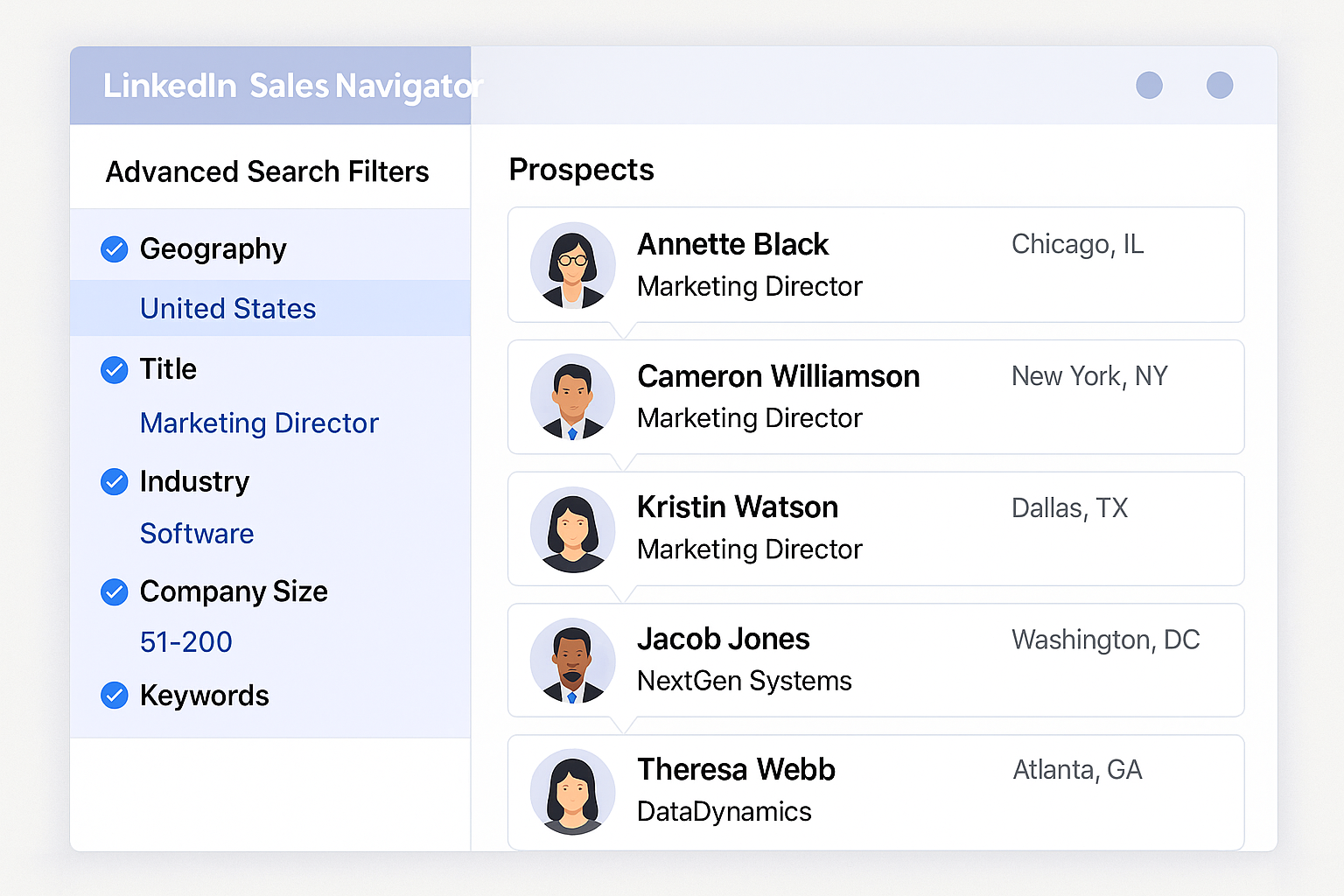
Leverage Tools
Manual research is slow and inefficient. Top-performing sales teams use technology to accelerate prospecting.
Sales Intelligence Platforms like ZoomInfo, Apollo.io, and Uplead provide vast databases of company and contact information, including direct-dial phone numbers and verified email addresses.
Email Finders & Verification are crucial – without accurate, verified email addresses, even the most personalized outreach fails. This is where quality b2b sales tools make the difference between success and failure.
Parameters to Engage B2B Decision Makers
Finding the right people is only half the battle. Now you need to engage them in a way that cuts through noise and builds trust.
Create a Buyer Persona
An Ideal Customer Profile defines the company you target. A buyer persona defines the person inside that company you need to persuade.
Go beyond demographics and job titles. Capture their professional reality:
- Goals: What does success look like for them?
- Challenges: What keeps them up at night?
- KPIs: How is their performance measured?
- Information sources: Which blogs, podcasts, or industry groups do they trust?
The best way to build personas? Talk to existing customers. Ask directly: “What were the biggest challenges that led you to look for a solution like ours?”
Personalized Outreach
Generic mass emails are the fastest way to get ignored. 71% of consumers expect personalized interactions from companies – it’s not optional anymore.
True personalization goes beyond [First Name] merge fields. It demonstrates you’ve done homework and respect their time.
Example: Selling access control systems
- To IT Head: Focus on seamless integration, data encryption, and GDPR compliance. Subject: “Question about integrating new access control with [Company]’s existing security stack.”
- To CFO: Emphasize ROI, reduced operational costs, and long-term financial value. Subject: “An idea to reduce [Company]’s facility costs by 15%.”
- To Facilities Manager: Highlight ease of use, remote access management, and user-friendly dashboards with a 2-minute demo video.
Use Thought Leadership Content
Modern B2B buyers complete 57% to 69% of their buying journey before ever speaking to a sales rep. During this phase, your content is your silent salesperson.
🎯 Target Decision Makers Directly
Stop waiting for inbound. Our LinkedIn campaigns put you in front of buying committees now.
79% of buyers say thought leadership is critical in deciding which vendors to consider. Effective content includes:
- Original research reports with unique insights
- In-depth guides solving major problems
- Expert webinars that educate rather than pitch
- Data-backed case studies with measurable results
A skilled content writer social media expert can help create and distribute this valuable content across platforms, ensuring it reaches decision makers where they’re already active.
Build Relationships
People buy from people they know, like, and trust. Your goal is evolving from vendor to trusted advisor.
Provide value in every touchpoint: Ditch “just checking in” emails. Every interaction should offer something valuable – a relevant article, network introduction, or industry insight.
Practice active listening: When you get them on calls, your primary goal is understanding, not talking. Ask thoughtful questions and listen intently.
Multi-thread relationships: Build genuine connections with multiple buying committee members. This builds broader consensus and protects your deal if your champion leaves.
Be patient and persistent: Real B2B relationships take time. Stay professionally persistent and focus on the long game.
Bottom Line
The path to closing more deals isn’t about better scripts or flashier demos. It’s about becoming a trusted guide who helps the entire buying
⚡ Bypass Manual Prospecting Completely
Our proven LinkedIn outbound engine delivers qualified meetings with multiple buying committee members.
7-day Free Trial |No Credit Card Needed.
Success requires accurate data as fuel. Having correct, verified email addresses isn’t just a detail – it’s the first and most crucial step in turning strategy into revenue.
Modern b2b marketing and b2b sales success comes from understanding that decision makers aren’t individuals anymore – they’re committees. Master the art of committee consensus-building, and you’ll consistently outperform competitors still hunting for single decision makers.
FAQs
Who are B2B decision makers?
What's the most effective way to find decision maker contact information?
How do I get past gatekeepers?
What's the difference between decision makers and influencers?

Connect with Decision Makers Faster
Skip the research. Our LinkedIn outbound engine books meetings with your ideal buyers.

